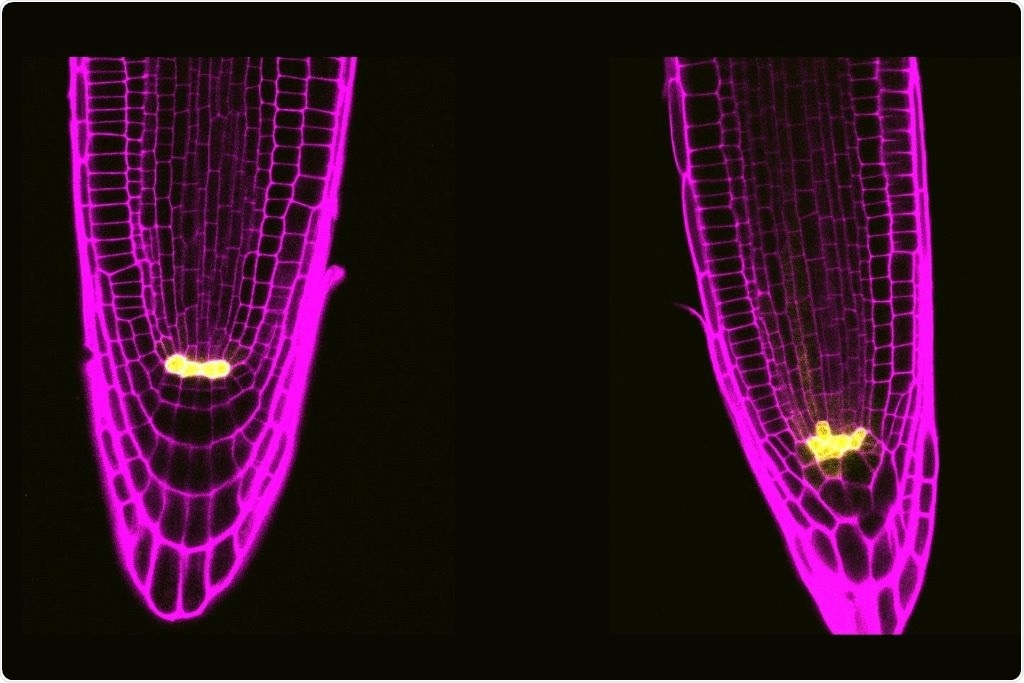A multidisciplinary team of researchers headed by Ana I. Cao Delgado, a CSIC biologist at CRAG, and Marta Ibaes, a physicist at the University of Barcelona, discovered that two plant stem cell proteins, familiar for their role in proper root development, physically interact and regulate each other to prevent cellular division.

Arabidopsis roots stained and visualized under a confocal microscope. The root cells contour is shown in pink. In yellow, the stem cells from the quiescent center. In the left, a wild-type root, and in the right, a root with mutated BRAVO and WOX5 genes. These mutations produce the division of the cells of the quiescent center, which are more abundant in the right image. Image Credit: CRAG.
The study is the result of 15 years of continuous research by the researchers and reveals that these two proteins, known as BRAVO and WOX5, act in a specific way in a small group of stem cells and that their interaction is critical to the plant’s survival under genomic and environmental stress factors such as extreme cold, heat, or flooding.
The findings, which were acquired using the Arabidopsis thaliana model plant, were recently published in the high-impact journal Molecular Systems Biology.
This discovery would not have been conceivable without combining the knowledge and academic disciplines supplied by both study teams: biochemistry, genetics, and cellular biology on the one hand, and mathematical modeling on the other.
Previous studies by our team and others from other teams had shown that the loss of one of these proteins (BRAVO or WOX) generates the division of the root’s stem cells. However, the molecular relation was not understood yet.”
Ana I. Caño Delgado, CSIC Biologist, CRAG
“In general, genic regulations involve a complexity that is not very intuitive most of the time, and which is only understood by means of mathematical models and computing simulations. The mathematical models we created could provide a sense to the great amount of gathered data by the CRAG team,” said Marta Ibañes, a researcher at the UB Institute of Complex Systems.
These new mathematical models will now enable in silico testing, simulating potential events that could occur at the root’s stem cells, such as the action of hormones or possible stress responses.
The quiescent center: A reservoir of stem cells
Plants have stem cells at the tip of their major roots, which allow them to grow indefinitely. The bulk of these cells reproduce rapidly, producing more stem cells as well as the various cells that make up the root’s tissues, including the epidermis and vascular tissue.
However, there are a few stem cells at one end of this niche that divide at a slower rate, which is why the area they inhabit is known as the “quiescent center.”
Every time a cell repeats its genetic material to divide, it faces the danger of introducing replication mistakes, which can lead to mutations that are harmful to the organism. This is why the quiescent center’s stem cells serve as a safety net, a pool of genetically unaffected cells. These cells can “wake up” and divide to fill the stem cell niche if necessary.
The BRAVO and WOX5 proteins perform their critical job of slowing cell division in these few cells of the quiescent center.
We created Arabidopsis plants with the BRAVO and WOX5 genes mutated simultaneously and observed that they had less capacity to regenerate roots, which were shorter and less abundant.”
Isabel Betegón-Putze, Study First Author
During her Ph.D., Betegón-Putze conducted these studies. At the stem cell niche, two distinct responses occur in response to severe or protracted stress: the death of fast-dividing stem cells and the activation of quiescent center cells.
The quiescent center cells become active following a root apex incision, root freezing, or lead poisoning, for example. Thus, they replace the dead stem cells, thereby enabling the root to continue growing and developing normally, ensuring the plant’s nutrition and support.
Gaining insights into the molecular mechanisms that control these processes is critical for developing more resilient crops, especially as climates become harsher.
An extraordinary source of youth
In contrast to animals, plants may create new organs (leaves, flowers, and so on) at any age and continue to grow throughout their lives (which can last over 2000 years!). Animal and plant stem cells appear to employ comparable tactics to solve similar biological challenges, but the molecular pathways that control them appear to be distinct.
A knowledge of these differences can be useful to develop valuable medical and cosmetic treatments for slowing cellular aging and promoting the regeneration of damaged tissue. This study, along with others led by Ana I. Cao-Delgado, is a step in the right direction.
Source:
Journal reference:
Betegón-Putze, I., et al. (2021) Precise transcriptional control of cellular quiescence by BRAVO/WOX5 complex in Arabidopsis roots. Molecular Systems Biology. doi.org/10.15252/msb.20209864.